DIY Buffer / Interface / Patchbay
THURSDAY, NOVEMBER 5, 2020
Design your own DIY Pedalboard Buffer Interface!

The diagrams, templates, and materials listed correspond to this video (shown below), where I show all you DIYers
how to build a Pedalboard Buffer Interface system just like the pros! All of the info you'll need to design your own
customized buffer with options for mono, stereo, wet/dry, split mono, effects loops or 4 cable method, audition
loops, tuner outs, and more are all available as you scroll down the page.
The Mono Dual Buffer is ideal for any MONO pedalboard system running in front of an amplifier.
Application Example, Block Diagram
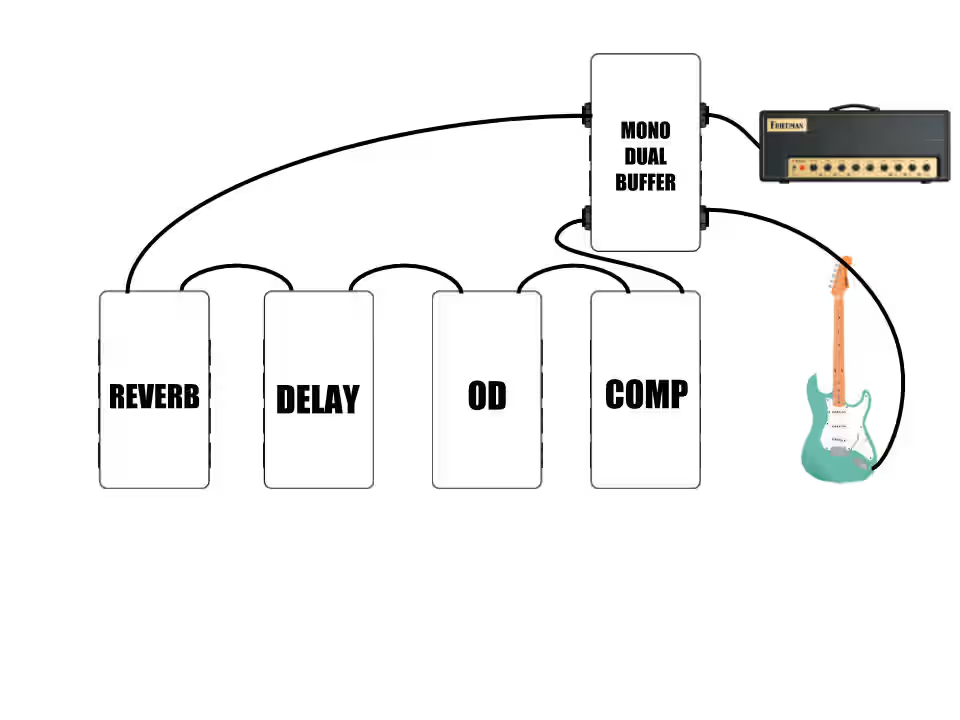
Drilling Template (Hammond 1590B Enclosure)
Download Diagram Here *Print at 100% Scale*

Wiring Diagram (shown from inside enclosure)
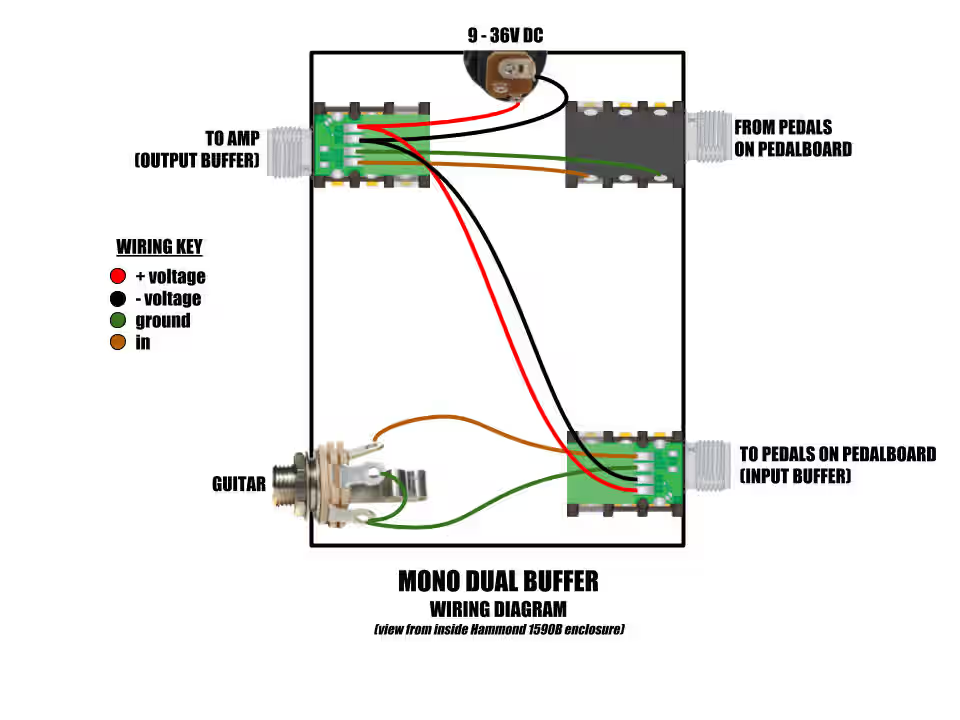
Bill of Materials:
1x Hammond 1590B Enclosure:
2x Creation Audio Labs Buffer PCB (select 1 Meg Ohm, Nylon ISO Jack, Unity Gain):
1x Neutrik NRJ6HF 1/4" TRS Jack(s):
1x Neutrik NRJ 1/4" Nut(s):
1x Switchcraft Tip Shunt 1/4" Jack(s):
1x DC Power Jack:
4x Keystone Hole Plugs:
1x Hook Up Wire:
MONO DUAL BUFFER WITH TUNER OUT
The Mono Dual Buffer is ideal for any MONO pedalboard system running in front of an amplifier.
The Tuner Out provides a buffered feed to your tuner, and allows you to remove the tuner from
your signal path while still getting a direct feed from your input. This could also be used as a
direct out or clean (unaffected) output for re-amping.
Application Example, Block Diagram
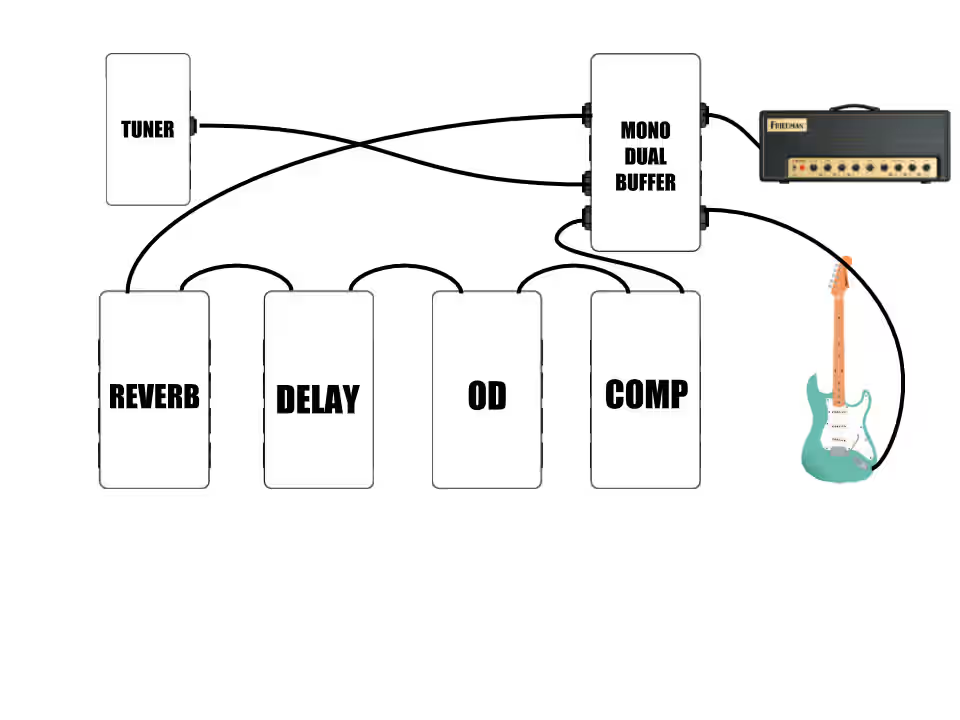
Drilling Template (Hammond 1590B Enclosure)
Download Diagram Here *Print at 100% Scale*

Wiring Diagram (shown from inside enclosure)

Bill of Materials:
1x Hammond 1590B Enclosure:
2x Creation Audio Labs Buffer PCB (select 1 Meg Ohm, Nylon ISO Jack, Unity Gain):
2x Neutrik NRJ6HF 1/4" TRS Jack(s):
2x Neutrik NRJ 1/4" Nut(s):
1x Switchcraft Tip Shunt 1/4" Jack(s):
1x DC Power Jack:
3x Keystone Hole Plugs:
1x Hook Up Wire:
MONO DUAL BUFFER / SPLITTER
The Mono Dual Buffer is ideal for any MONO pedalboard system running in front of an amplifier.
The Splitter Out provides a buffered feed for a second MONO amplifier. You can now use up to
two amplifiers that can provide a BIGGER mono sound and help fill in your tonal EQ and body.
*NOTE: Some multi-amp set-ups may require galvanic isolation and/or polarity reversal on one amp. We suggest the Lehle
P Split as a solution, placed as close to the amplifier as possible for the transformer isolation, and the polarity (phase) controls.
Application Example, Block Diagram

Drilling Template (Hammond 1590B Enclosure)
Download Diagram Here *Print at 100% Scale*
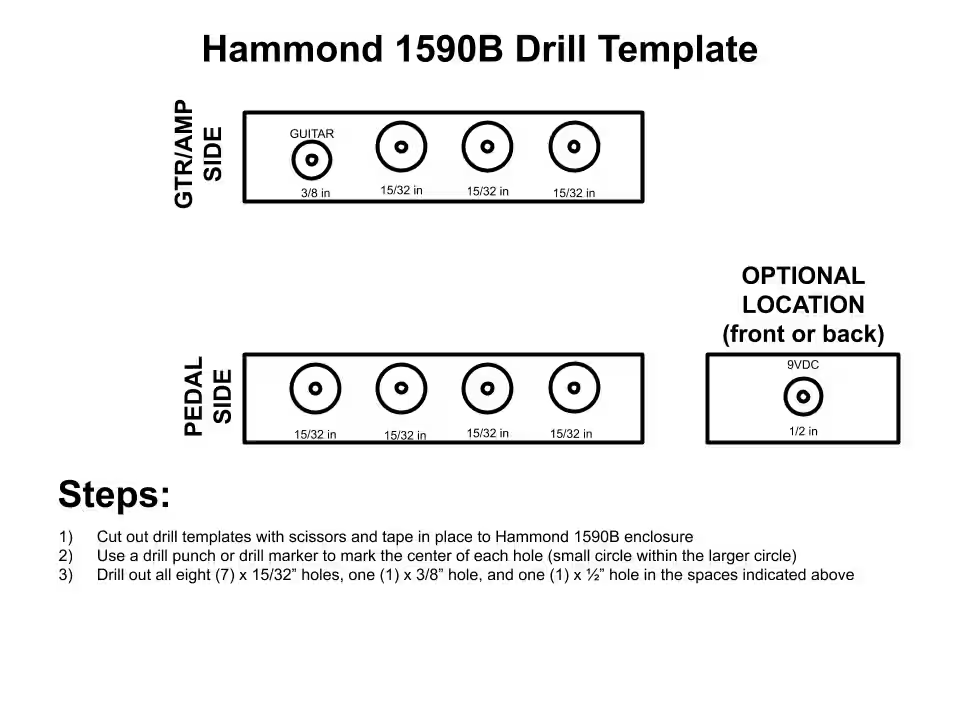
Wiring Diagram (shown from inside enclosure)

Bill of Materials:
1x Hammond 1590B Enclosure:
2x Creation Audio Labs Buffer PCB (select 1 Meg Ohm, Nylon ISO Jack, Unity Gain):
2x Neutrik NRJ6HF 1/4" TRS Jack(s):
2x Neutrik NRJ 1/4" Nut(s):
1x Switchcraft Tip Shunt 1/4" Jack(s):
1x DC Power Jack:
3x Keystone Hole Plugs:
1x Hook Up Wire:
MONO DUAL BUFFER + AUDITION LOOP (INSERT)
The Mono Dual Buffer is ideal for any MONO pedalboard system running in front of an amplifier.
The Audition Loop provides an insert point for pedals to be used in specific locations of the FX
signal path. Typically used for external volume pedals, wahs, or pedals that may be the "pedal du jour"
for a gig or session inserted before/after overdrives and time based pedals, but off the pedalboard.
Application Example #1, Block Diagram
normalized, no audition pedal connected to insert point

Application Example #2, Block Diagram
audition loop active, external pedal inserted into signal path

Drilling Template (Hammond 1590B Enclosure)
Download Diagram Here *Print at 100% Scale*

Wiring Diagram (shown from inside enclosure)

Bill of Materials:
1x Hammond 1590B Enclosure:
2x Creation Audio Labs Buffer PCB (select 1 Meg Ohm, Nylon ISO Jack, Unity Gain):
5x Neutrik NRJ6HF 1/4" TRS Jack(s):
5x Neutrik NRJ 1/4" Nut(s):
1x Switchcraft Tip Shunt 1/4" Jack(s):
1x DC Power Jack:
0x Keystone Hole Plugs:
1x Hook Up Wire:
FOUR CABLE METHOD or WET/DRY (TRI BUFFER)
Four Cable Method is ideal for a MONO pedalboard system where all the distortion, overdrive, and
other "dry" effects are running in front of an amplifier preamp, while the "wet" effects (like reverb
and delay) are running between the preamp and power amp, in the amplifier FX Loop (send/return).
Wet/Dry similarly is ideal for a MONO pedalboard system where all the distortion, overdrive, and other
"dry" effects are running in front of the amplifier preamp. However, the "wet" effects (like delay and reverb)
are fed by a line out box (a line level output tapped off the output transformer padded down to line level)
that feed the "wet" effects (set to 100% wet/kill dry), wired into a parallel mixer. The mixer then feeds
either A) the power amp that feeds the "wet" speaker cabinet, or B) a cab/speaker simulator that feeds
a balanced output to your DAW or FOH, or C) directly feeds your DAW or FOH (some pedals and rack gear
can feed a balanced output via XLR/TRS directly out of the device itself to an interface or mixer).
*NOTE: Wet/Dry systems require a line-out box and a parallel mixer for your "wet" fx. For Line Out, we recommend the Bray LO-1.
In some instances, you may need galvanic isolation for your line out, for this, we recommend the Suhr ISO Line Out Box. For parallel
mixers we recommend the Musicom Lab Parallelizer to mix up to three wet effects devices in parallel, it also includes a dry mix control.
Application Example #1, FOUR CABLE METHOD (4CM)
for use with an amplifier with an fx loop

Application Example #2, WET/DRY
for use with a line out box, parallel mixer (FX set to 100% wet/kill dry), dry amp & speaker cab, plus power amp & wet speaker cab

Application Example #3, All FX IN SERIES
for use with all fx in series in front of an amplifier, when you can't do 4CM or W/D, simply use the "return" jack as your "output" jack
and all of the effects in the fx loop or w/d will be re-routed, in series, after all of the dry fx - all pedals will now run into the front of amp

Drilling Template (Hammond 1590B Enclosure)
Download Diagram Here *Print at 100% Scale*

Wiring Diagram (shown from inside enclosure)

Bill of Materials:
1x Hammond 1590B Enclosure:
3x Creation Audio Labs Buffer PCB (select Ai1 model, 1 Meg Ohm, Nylon ISO Jack, Unity Gain):
4x Neutrik NRJ6HF 1/4" TRS Jack(s):
4x Neutrik NRJ 1/4" Nut(s):
1x Switchcraft Tip Shunt 1/4" Jack(s):
1x DC Power Jack:
0x Keystone Hole Plugs:
1x Hook Up Wire:
STEREO TRI BUFFER + TUNER OUT
The Stereo Tri Buffer is ideal for any STEREO pedalboard system running in front of two amps.
The Tuner Out provides a buffered feed to your tuner, and allows you to remove the tuner from
your signal path while still getting a direct feed from your input. This could also be used as a
direct out or clean (unaffected) output for re-amping your guitar.
your signal path while still getting a direct feed from your input. This could also be used as a
direct out or clean (unaffected) output for re-amping your guitar.
*NOTE: Some multi-amp set-ups may require galvanic isolation and/or polarity reversal on one amp. We suggest the Lehle
P Split as a solution, placed as close to the amplifier as possible for the transformer isolation, and the polarity (phase) controls.
Application Example, STEREO AMPLIFIERS + TUNER OUT
for use with two amps, stereo L & R, with buffered tuner feed from tuner out - tuner out could also be used as "dry" for re-amping

Drilling Template (Hammond 1590B Enclosure)
Download Diagram Here *Print at 100% Scale*
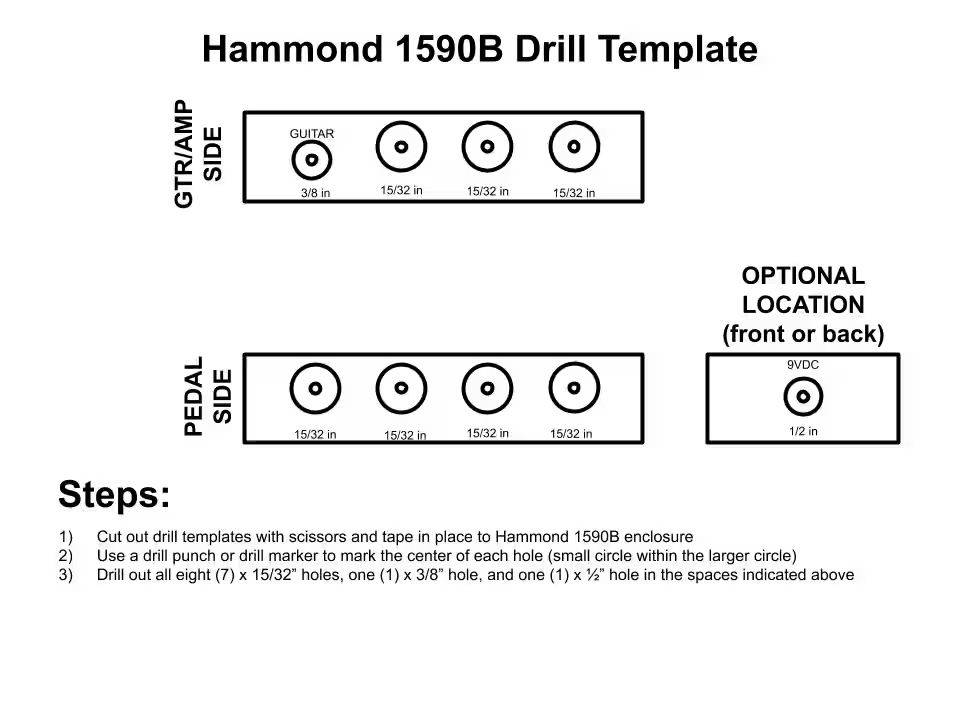
Wiring Diagram (shown from inside enclosure)

Bill of Materials:
1x Hammond 1590B Enclosure:
3x Creation Audio Labs Buffer PCB (select 1 Meg Ohm, Nylon ISO Jack, Unity Gain):

